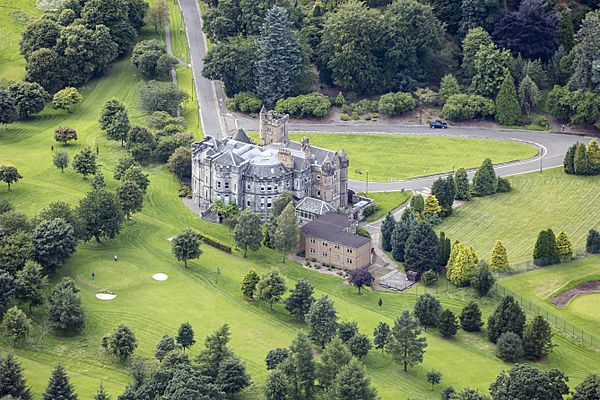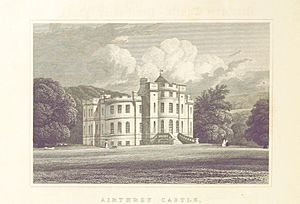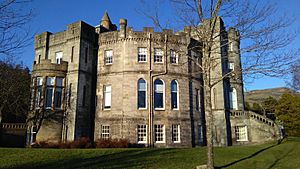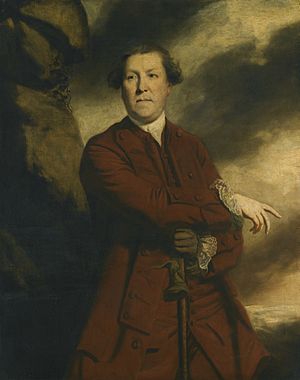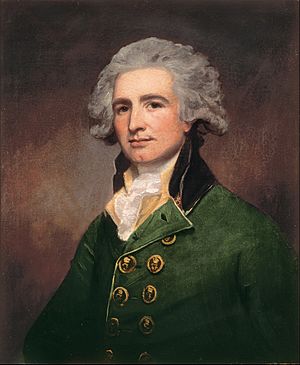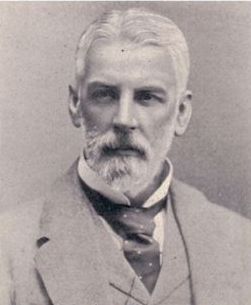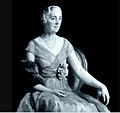Airthrey Castle facts for kids
Airthrey Castle is a historic building and large estate. It is now part of the University of Stirling in central Scotland. The castle was built in the 1700s, with more parts added in the 1800s. It sits in beautiful gardens on the edge of the Ochil Hills. The castle overlooks the Forth valley. It is near Bridge of Allan, about 2 miles from the historic city of Stirling.
Contents
What's in a Name?
The name "Airthrey" might come from a few different places. One idea is that it comes from "Ard-rhedadie." This means "a high or ascending road." This could be about an old road that went through the area to Sheriffmuir.
Another idea is that it comes from the Gaelic word "Aithrin." This means "a sharp point" or "conflict." This might refer to a battle fought near the castle in 839. In this battle, the Picts were defeated by the Scots. Some standing stones in the park are said to remember this battle.
A third idea links the name to Brythonic words. It could be like the modern Welsh "ard tref," meaning "high farmstead." This is similar to the name of Airdrie in Lanarkshire.
A Castle Through Time
Early Days
In medieval times, the land of Airthrey belonged to monks. The name "Aithrey" appears in a document from King David I before 1146. In 1370, the estate was given to Sir John Herice. He was the Keeper of the nearby Stirling Castle.
Later, the land went to William Graham, 3rd Lord Graham. He likely took ownership around 1472. He became the Earl of Montrose in 1504. The estate stayed with the Clan Graham family for many years.
In 1645, the manor house at Aithrey was burned down. This was done by Archibald Campbell, 1st Marquess of Argyll. It was said to be revenge for an attack on his own estate.
The Hopes of Hopetoun
In 1678, John Hope of Hopetoun bought the estate. His family made money from lead mines. John Hope died in 1682 when his ship sank. He reportedly gave up his spot on a rescue boat to the Duke of York. The Duke later became King James II.
John Hope's son, Charles Hope, 1st Earl of Hopetoun, inherited the estate. In 1703, Queen Anne made him an Earl. This was said to be thanks for his father saving King James II. Airthrey was not his main home, though. He lived at Hopetoun House.
The Dundas Family
In 1706, Ralph Dundas of Manour bought Airthrey. A story says that the Dundas family traded a small property for the much larger Airthrey estate. This was a very good deal for them.
In 1747, John Dundas of Manour rebuilt Airthrey House. His nephew-in-law, the writer John Ramsay of Ochtertyre, called it "a small snug house." John Dundas spent his time reading books there.
The Haldanes
In 1759, John Dundas sold Airthrey to Captain Robert Haldane. He was a very rich man who had made his money in India. He wanted to make his estate beautiful. He built new roads and closed old public ones.
In 1768, Captain Haldane's great-nephew, Robert Haldane, inherited the estate. In 1791, he built a new house. He called it Airthrey Castle. It was designed by the famous architect Robert Adam.
Haldane also had the 363-acre (1.47 km2) grounds landscaped. This included a man-made 23-acre loch. There was also a small hermitage and a 4-mile boundary wall. It is said that Haldane looked for a full-time hermit to live in the hermitage!
After spending so much on the estate, Robert Haldane decided to change his life. He chose to sell his estates and work on religious missions. He built churches and schools in Scotland. He also helped start a religious movement in Geneva.
The Abercrombies
In 1798, Robert Haldane sold Airthrey to General Sir Robert Abercromby. He was a famous soldier who had served in America and India. He made his money from military victories.
There were special springs on the Airthrey estate. People had known about their healing qualities since the 1700s. In the 1820s, Sir Robert had the water tested. Scientists confirmed its high mineral content.
Sir Robert decided to share the water with the public. He built a proper well-head. The "Airthrey waters" became famous. Many people came to drink them. This led to Bridge of Allan becoming a popular spa town. Sir Robert Abercromby died at Airthrey in 1827. He was 87 years old.
The Grahams
The Abercromby family owned Airthrey for over 100 years. In 1889, George Abercromby, 4th Baron Abercromby sold the estate to Donald Graham. He was a rich merchant from Glasgow. His business was based on trade with India.
Donald Graham added a large part to the castle between 1889 and 1891. He changed the north side of the castle to a Scottish Baronial style. The original design by Robert Adam can still be seen on the south side. The Graham family's coat of arms is in a stained glass window.
Airthrey Loch was popular for curling and ice skating. But in 1901, a sad accident happened. Frederick Pullar, a young surveyor, died while trying to rescue a lady. After this, the curling club rarely used the loch. Donald Graham died in 1901 after a carriage accident. The estate went to his widow, Clara Graham.
A Hospital During Wartime
In 1939, when World War II began, Airthrey Castle became an emergency maternity hospital. This was part of a plan to move people away from cities. Mrs. Charles Donaldson, the last private resident, helped set it up.
The hospital had 25 beds. It became very busy after the 1941 Clydebank Blitz. Some babies born there were even named "Airthrey." In 1941, the Graham family leased the castle to Stirling County Council. It continued as a maternity hospital until 1969.
In 1947, the Grahams sold the Airthrey estate to developers. This ended its time as a private home. The castle and its nearby grounds were bought by Stirling County Council. They leased it to the National Health Service.
University of Stirling
In the 1960s, Airthrey estate was chosen for a new Scottish university. This was the first completely new university in Scotland since the University of Edinburgh was founded in 1582. The beautiful location at Airthrey helped in this choice.
The University of Stirling opened in 1967. Its campus covers 60 acres (240,000 m2) of woodland and 300 acres (1.2 km2) of landscaped parkland. It also has a loch with lots of wildlife. Airthrey Castle is now part of the university. Since 2014, it has been home to the University's international study center.
A Protected Building
Airthrey Castle still has many of its original features. It is a category B listed building. This means it is an important historic building that is protected.
Gallery
Images for kids


